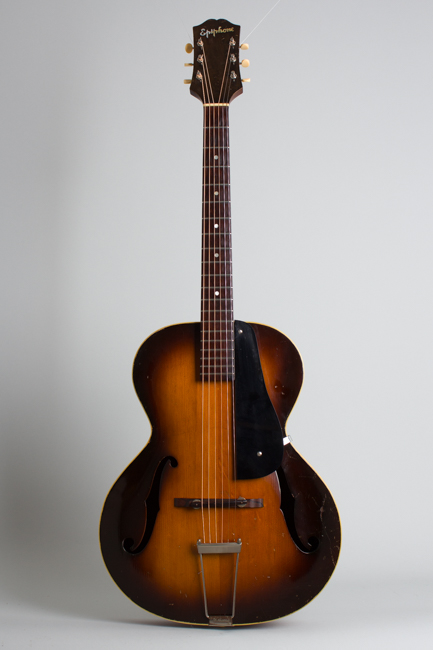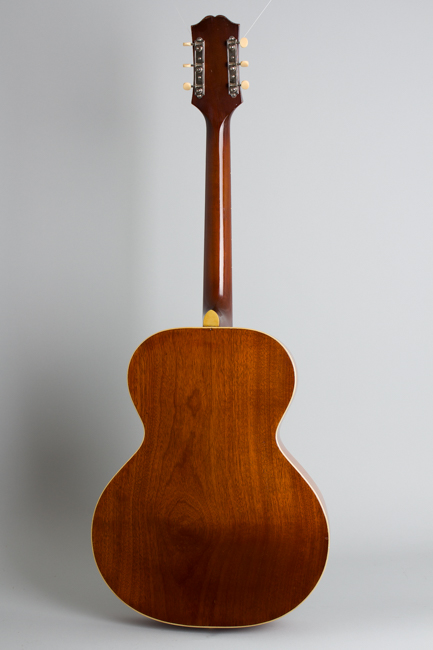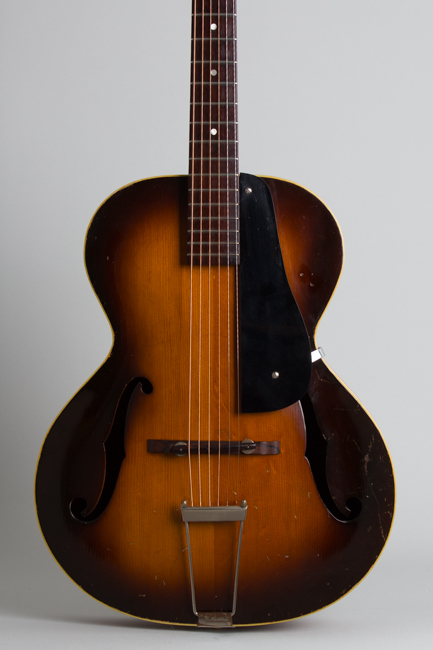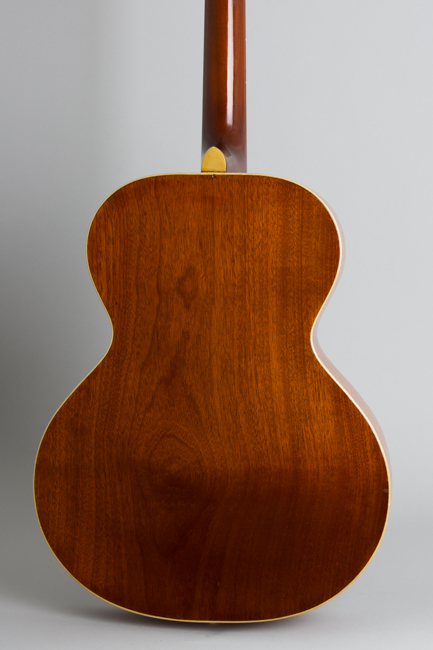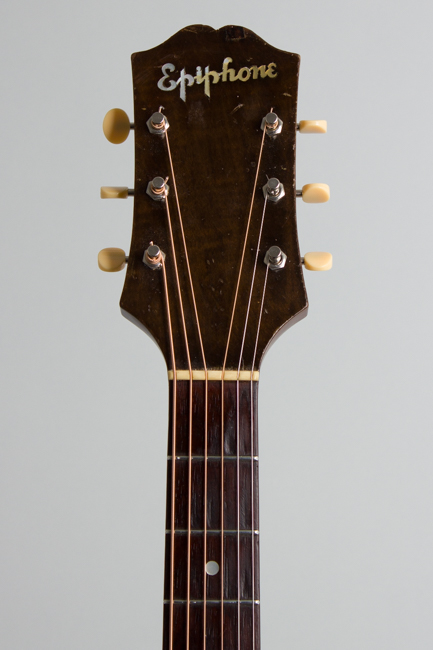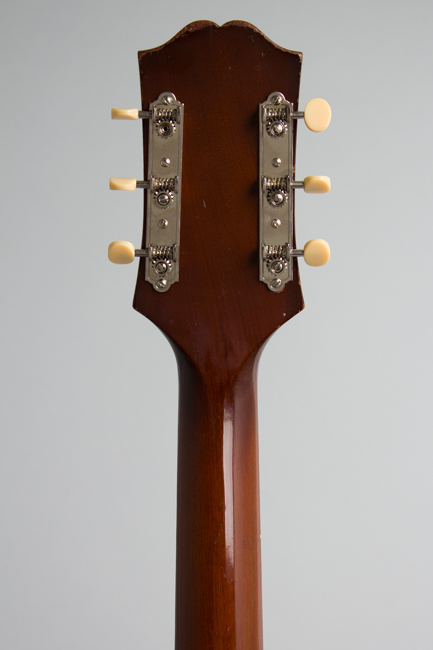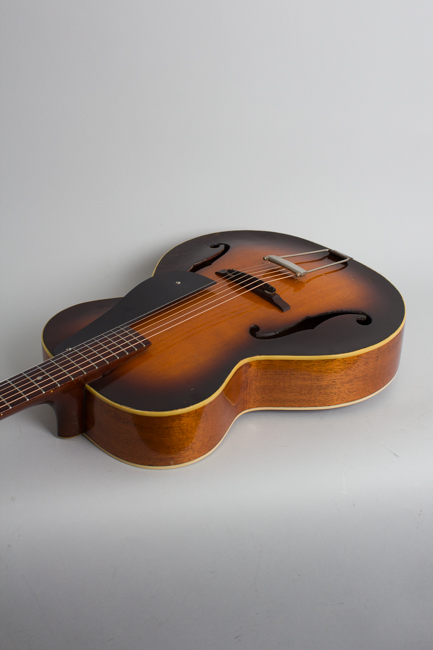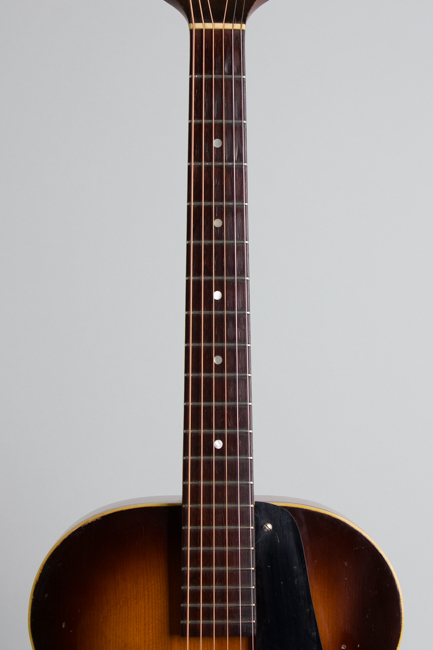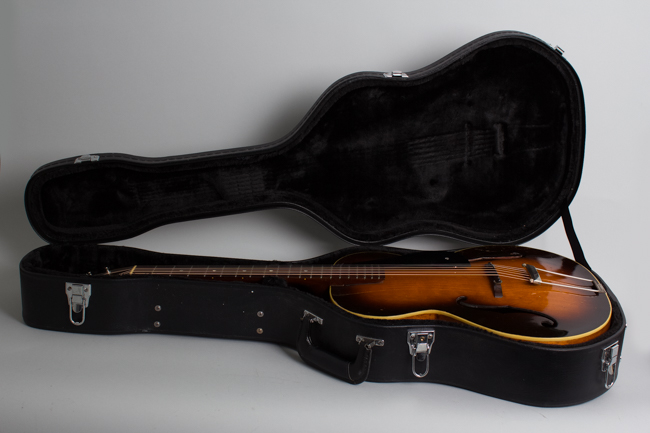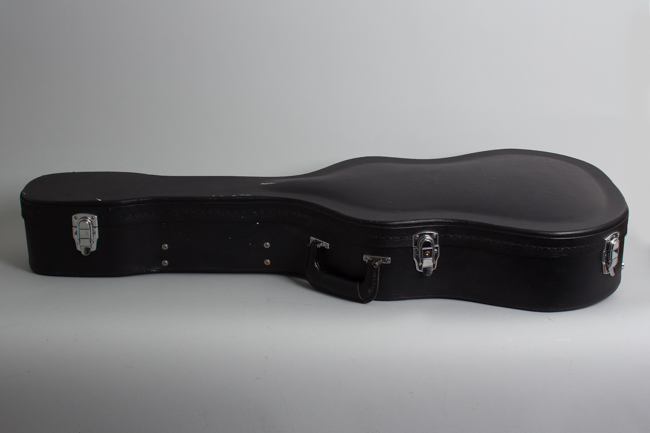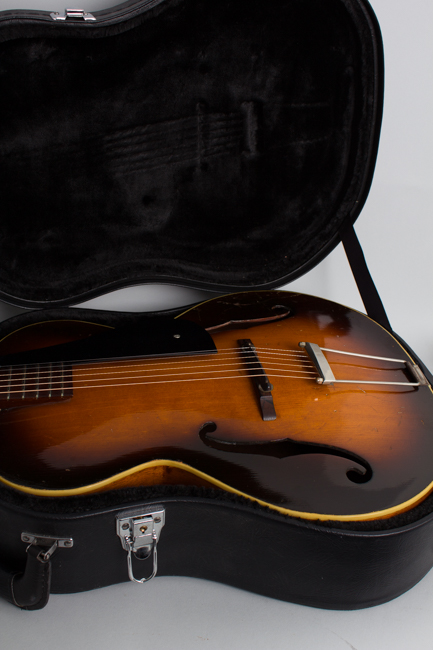Epiphone Olympic Arch Top Acoustic Guitar (1941)
This item is currently on hold.
Item # 12379
Prices subject to change without notice.
Epiphone Olympic Model Arch Top Acoustic Guitar (1941), made in New York City, serial # 17268, sunburst top, natural back and sides finish, mahogany back and sides, spruce top; mahogany neck with rosewood fingerboard, black tolex hard shell case.
The Olympic sat at the bottom of the original 1930s Epiphone line, the lowest priced carved-top guitar the company offered. When this one was made in late 1941 the model carried a $35 price tag; the Emperor listed at $400. By this time the originally very small body had been increased to a more generous 15 5/8" wide making it a more professional sized guitar, if a relatively plain one. "The Olympic has all the Epiphone features and is built by the same highly skilled workmen as the higher priced models" trumpeted the company catalogs.
The back and sides are mahogany, the top carved spruce, parallel braced worked quite thin contributing to the bright, punchy sound. The body edges have single-layer white celluloid binding, with the typical Epiphone rosewood bridge, plain black pickguard and trapeze tailpiece. The neck is quite slim for the period with a "rounded V' profile and a narrow (for 1941) 1 5/8" nut. The rosewood fretboard has plain dot inlay. The "open book" headstock has a pearl Epiphone logo
While hardly a showpiece the pre-war Olympic is a very well crafted instrument and boasted several advantages over other budget archtops of the time. The long 25 1/2" scale enhanced tone and power; budget Gibson archtops of the time had a shorter 24 3/4" scale. Despite their bottom-of-the-line status original 1930's Epiphone Olympics are fairly rare today, especially in good playing condition.
Overall length is 40 5/8 in. (103.2 cm.), 15 5/8 in. (39.7 cm.) wide at lower bout, and 3 5/16 in. (8.4 cm.) in depth, measured at side of rim. Scale length is 25 1/2 in. (648 mm.). Width of nut is 1 5/8 in. (41 mm.).
This guitar is an excellent player and a surprisingly good sounding instrument for its original budget status. The sunburst top finish remains original but the back and sides have been refinished, with a thinner clear overspray on much of the neck. The top has some wear with a couple of heavier scratches and some smaller dings and dents. The back and sides have only very light wear to the (later) finish, The neck finish also shows some light wear to the back.
There are no visible crack repairs. There is a small patched chip at the top of the headstock face. The neck looks to have been reset and the fingerboard refretted, the frets show some light wear but play fine. The fingerboard has some light divoting in the lower positions. The hardware is a mixed bag with original adjustable bridge and simple trapeze tailpiece but modern repro tuners and a correct style repro pickguard. This is a nice player with a tight, punchy sound and plenty of volume but also a sweeter sound if played more gently. It lives in a modern HSC. Overall Very Good + Condition.
The Olympic sat at the bottom of the original 1930s Epiphone line, the lowest priced carved-top guitar the company offered. When this one was made in late 1941 the model carried a $35 price tag; the Emperor listed at $400. By this time the originally very small body had been increased to a more generous 15 5/8" wide making it a more professional sized guitar, if a relatively plain one. "The Olympic has all the Epiphone features and is built by the same highly skilled workmen as the higher priced models" trumpeted the company catalogs.
The back and sides are mahogany, the top carved spruce, parallel braced worked quite thin contributing to the bright, punchy sound. The body edges have single-layer white celluloid binding, with the typical Epiphone rosewood bridge, plain black pickguard and trapeze tailpiece. The neck is quite slim for the period with a "rounded V' profile and a narrow (for 1941) 1 5/8" nut. The rosewood fretboard has plain dot inlay. The "open book" headstock has a pearl Epiphone logo
While hardly a showpiece the pre-war Olympic is a very well crafted instrument and boasted several advantages over other budget archtops of the time. The long 25 1/2" scale enhanced tone and power; budget Gibson archtops of the time had a shorter 24 3/4" scale. Despite their bottom-of-the-line status original 1930's Epiphone Olympics are fairly rare today, especially in good playing condition.
Overall length is 40 5/8 in. (103.2 cm.), 15 5/8 in. (39.7 cm.) wide at lower bout, and 3 5/16 in. (8.4 cm.) in depth, measured at side of rim. Scale length is 25 1/2 in. (648 mm.). Width of nut is 1 5/8 in. (41 mm.).
This guitar is an excellent player and a surprisingly good sounding instrument for its original budget status. The sunburst top finish remains original but the back and sides have been refinished, with a thinner clear overspray on much of the neck. The top has some wear with a couple of heavier scratches and some smaller dings and dents. The back and sides have only very light wear to the (later) finish, The neck finish also shows some light wear to the back.
There are no visible crack repairs. There is a small patched chip at the top of the headstock face. The neck looks to have been reset and the fingerboard refretted, the frets show some light wear but play fine. The fingerboard has some light divoting in the lower positions. The hardware is a mixed bag with original adjustable bridge and simple trapeze tailpiece but modern repro tuners and a correct style repro pickguard. This is a nice player with a tight, punchy sound and plenty of volume but also a sweeter sound if played more gently. It lives in a modern HSC. Overall Very Good + Condition.
